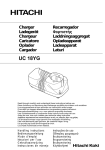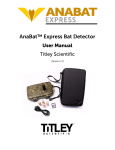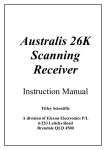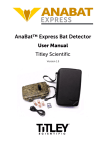Download Short Term Operating Reserve (STOR)
Transcript
Short Term Operating Reserve (STOR) Frequently Asked Questions Version 2.0 November 2013 For Further Information please contact: Contracts & Settlements National Grid House, Warwick Technology Park Gallows Hill Warwick CV34 6DA T: E: W: +44 (0)1926 654611 [email protected] http://www2.nationalgrid.com/uk/services/balancing-services/reserve-services/short-term-operatingreserve/ About this Document This document has been written for all existing providers and potential new providers of the Short Term Operating Reserve (STOR) service. It is intended to provide a reference point and supplemental guidance to parties and should be read in conjunction with the appropriate documents available on the STOR pages of the website which can be found at the following link National Grid: Short Term Operating Reserve (STOR). CONTENTS ¾ INTRODUCTION 1 ¾ BACKGROUND 2 ¾ PRACTICALITIES OF THE SERVICE 5 ¾ TENDER INFORMATION 11 ¾ AGENTS / AGGREGATORS 13 ¾ ASSESSMENT 15 ¾ INDEXATION 16 ¾ OPERATION OF THE STOR SERVICE 17 ¾ FAILURES 19 ¾ BM SPECIFICS 21 ¾ HOW DO I EFFECT CHANGES TO THE SERVICE? 22 ¾ WHERE CAN I FIND MORE DETAIL ON…? 23 ¾ FLOWCHART FOR NEW PROVIDER 25 ¾ WHO SHOULD I CONTACT…? 26 ¾ GLOSSARY 26 INTRODUCTION What is Short Term Operating Reserve (STOR)? National Grid Electricity Transmission plc (National Grid), as the National Electricity Transmission System Operator (NETSO) requires access to extra power in the form of either generation or demand reduction during certain periods of the day in order to manage situations where actual demand is greater than forecast demand and/or unforeseen generation unavailability. National Grid procures Short Term Operating Reserve (STOR) to help meet this reserve requirement. STOR is a contracted balancing service whereby the Service Provider delivers a contracted level of power (within pre-agreed parameters) when instructed by National Grid. The requirement for STOR varies depending on the time of year, week and day, being a function of the system demand profile at that time. The minimum capability requirements for the service are as follows: • offer a minimum of 3MW generation or steady demand reduction (this can be aggregated); • maximum Response Time for delivery of 240 minutes following instruction from National Grid, although we typically contract for 20 minutes or less; • ability to deliver the Contracted MW for a continuous period of not less than 2 hours; • have a Recovery Period after provision of Reserve of not more than 1200 minutes; • be able to deliver at least 3 times per week. 1 1 BACKGROUND When does National Grid need STOR? The need for STOR varies across the year, the time of week and time of day, being a function of the system demand profile at that time. To reflect this, National Grid splits a year into six Seasons which include both Working Days (including Saturdays) and Non Working Days (Sundays and most Bank Holidays), and specifies the periods or ‘windows’ in each day that STOR is required. Does size of units matter? To be able to tender for the STOR service, a potential Reserve Provider must have at least 3MW of either generation capability or demand reduction capability. National Grid’s Control Room despatch STOR units/sites at their discretion based primarily on economics. However, other factors can be taken into consideration including (but not limited to) response time, location and size of units. Please note: If a Reserve Provider successfully tendered for 3MW (for example) and then during a contracted availability window produced less than their contracted MW, that Reserve Provider would be subject to various payment penalties. A link to our STOR Assessment principles can be found at the end of this document. Does National Grid prefer Demand Reduction or Generation Units? National Grid does not differentiate for the purposes of Assessment. Does National Grid have a geographical location preference for sites/units? Whilst location is a factor in determining whether a unit will be accepted or rejected, the primary assessment focuses on economics. SCOTLAND NORTH SOUTH NB. Boundaries shown are indicative only. 2 2 However, because multiple constraint boundaries exist across Great Britain, potential providers of STOR are advised to speak to a National Grid Account Manager in order to fully understand and appreciate the locational implication of these boundaries. Further, in order to participate in the STOR programme the unit/site must have a connection to the Electricity Transmission/Distribution Network. Where do I look for sites that have connections to the Grid? Many of our STOR Units/Sites are connected to the local distribution networks – as such, please contact your local Distribution Network Operator direct. How is STOR procured? STOR is procured by National Grid via a competitive tender process with three tender rounds per year, whereby the Reserve Provider delivers a contracted level of power when instructed by National Grid, within pre-agreed parameters. Tenderers can tender in for one or more STOR seasons – there are six STOR seasons per year – up to a total contracted period of two years. The tender will contain all the required technical parameters associated with the service, as well as the Availability and Utilisation prices. Tenders are assessed by National Grid and either accepted or rejected; if accepted, the tender becomes binding on both parties. Interested parties must fulfill the pre-qualification requirement by signing up to the Framework Agreement before participating in the tender – this gives effect to the STOR Standard Contract Terms. A link to our STOR Assessment principles can be found at the end of this document. What is your STOR requirement on a daily basis? As National Electricity Transmission System Operator, National Grid maintains an Operating Reserve Requirement (ORR) from 4 hours ahead of time to real time, to take account of demand forecast errors, plant losses and market imbalance. The ORR is met by headroom on market synchronised machines, additional actions taken by National Grid via the Balancing Mechanism (BM) and contracted reserve products. STOR is a contracted reserve product and as such STOR tenders can make up a finite proportion of the ORR. The amount of contracted STOR required is determined by the size of the ORR which changes due to forecast market length, market provided headroom, volume of intermittent generation and demand forecast errors. The proportion of the ORR met by STOR is determined by considering the technical system requirements and also the forecast cost of alternatives versus the cost of the tendered STOR units. As detailed in the most recent Market Information Report TR18, throughout the STOR seasons National Grid aims to procure a minimum of 1800MW of STOR (subject to sufficient economics). The daily and seasonal optimal STOR MW level varies due to real time and also seasonal pressures on the system, but National Grid has typically engaged in having approximately 2300MW of STOR, when available. Looking ahead, the optimal STOR MW level is expected to be similar to the optimal STOR MW level experienced currently, however if the Operating Reserve Requirement (of which STOR is one part) changes, then the optimal STOR MW level will also change. The optimal STOR MW level is what National Grid expects to manage on a daily basis. National Grid examines historic availability profiles from committed and flexible providers to help determine the amount of STOR MW to 3 3 procure, such that the contracted STOR MW would yield the optimal STOR MW to be available on a daily basis, allowing for economics and pressures on the system. It is only STOR units that have a response time of 20 minutes or less, that are able to contribute to the optimal STOR MW level as these units are able to help manage system security during any unforeseen event. STOR units with a long notice response time (a response time greater than 20 minutes) do not contribute to the optimal STOR MW level, yet they are kept as reserve for system flexibility and can be used to manage planned events that occur on the system. Where economics are sufficiently strong, National Grid may procure long notice STOR over and above the optimal STOR MW level in order to ensure the Control Room’s operational resilience. What is your definition of ‘Reserve’? Our definition of ‘Reserve’ is outlined in section 5.3 of the SCTs and essentially requires contribution towards National Grid’s STOR requirement through delivery of each reserve provider’s contracted MW and this must either increase the net export of Active Power to, or reduce the net import of Active Power from (as the context requires), the Distribution System/Transmission System to which the contracted STOR site is connected. What is your approach to the sharing of capacity between a STOR provider and third party? National Grid has become aware that embedded STOR providers may have been approached by third parties requesting to install generation equipment on their contracted STOR site and to share their DNO connection. We are concerned that a consequence to such behaviour could result in third party generation being turned down in order to allow a STOR unit to export when despatched. It is therefore our view that any form of sharing of capacity between a Provider committed to STOR and a separate third party generator may not be appropriate as it could not be guaranteed that the net delivery from the point of connection would equate to the contracted STOR MW volume. Sub-paragraphs 2.10.3 and 3.10.3 of the SCTs set out the Reserve Providers obligations in this regard and ultimately upon notification from the Reserve Provider of such a sharing arrangement, National Grid retains the right to terminate the STOR contract. We therefore advise Reserve Providers to contact National Grid in such scenarios. 4 4 PRACTICALITIES OF THE SERVICE What is an Availability Window? The Availability Window is defined as being the period during which the Reserve Provider is required to be available to operate at Contracted MW. As a result of this, there is the possibility that a STOR Instruction may be issued prior to the commencement of the Availability Window (i.e. in order to achieve contracted MW by the time that the Availability Window starts). Please see illustration below: In addition, where delivery of Contracted MW is up to the end, or close to the end, of the Availability Window, there may be energy delivered outside the Window whilst the unit/site is returning to its default state. These are called preand post-window phases and are expressly defined under the service: The Pre-Window Instruction Period is equal to the Response Time, which is a tendered parameter. Response Time is defined as being the time that it will take a unit/site to reach the Contracted MW level after the Reserve Provider receives an Instruction from National Grid. The Post-Window Ramping Period is the time required for the unit/site to return to its default state, following the Instruction from National Grid. It is equivalent to the Cease Time, which is also a tendered parameter. Where a Reserve Provider declares availability from a unit/site, Availability Payments are made for the duration of the Availability Window, unless, in the case of a Flexible Service window, the availability is rejected by National Grid. The availability windows are defined as being the period during which the Reserve Provider is required to be available to operate the contracted MW. Availability windows are specified in the relevant tender sheets and vary depending on the season (there are six seasons a year). An example of the availability windows for one particular season are as detailed below: 5 5 Working Day Availability Windows (Mon-Sat) 07:00 – 13:30 16:30 – 21:00 Non-Working Day Availability Windows (Sun & BH) 10:30 – 13:30 16:30 – 21:00 Exact Availability windows for the current season, can be found on the Tender Sheets on the STOR page of National Grid’s website. Each year providers have the opportunity to make their unit/site available for a maximum of 3800 hours. What payments will National Grid make to us for providing STOR? There are two forms of payment that National Grid will make as part of the STOR service and both are defined by the Reserve Provider on the relevant tender sheets: Availability Payments Where a Reserve Provider makes its unit/site available for the STOR service within an availability window, National Grid will pay for that availability on a £/MW/hr basis. Utilisation Payments Where National Grid instructs delivery of STOR from a unit/site, then it will pay for the energy delivered on a £/MWhr basis. This includes the energy delivered in ramping up to and down from the Contracted MW level. Please note: Utilisation payments will be capped to the amount of energy contracted to be delivered in each settlement period. For BM Reserve Providers this payment will be effected through the Balancing Mechanism. Optional Utilisation Payments There is an opportunity for non-BM Reserve Providers to offer a service outside of Availability Windows. All periods outside Availability Windows (and associated pre and post Window periods) are defined as “Optional Windows”. Reserve Providers may indicate for each day their availability in Optional Windows. Where they indicate availability National Grid may utilise the service at the Optional Energy Utilisation Price. Please note that no Availability Payments will be made for service availability within any Optional Windows. Do I have to be available 24/7? Committed Service A Reserve Provider must make the service available for all Availability Windows and the only acceptable reasons for unavailability is where the unit/site is technically unable to provide the service. If you are on a committed contract, you are expected to be available for STOR for all windows for every day of the week and in return National Grid commits to buy all services offered. For Committed Service Providers a high percentage availability is expected, on the basis that there can only be unavailability relating to the technical capability of the plant. 6 6 In the event that the aggregate availability within any financial year is less than 85% then a process applies whereby a proportion of the Availability Payments paid over the contracted term becomes repayable. The basis of the reconciliation is 1% repayment of each percent of availability less than 85%. Both BM and Non-BM providers can offer the Committed Service. Flexible Flexible Service Providers have greater freedom as to how many hours they wish to make the service available, and when that availability is offered. National Grid is not obliged to accept and buy all the services offered at the week ahead stage and will not make Availability Payments for rejected Flexible Service Availability. A form of Availability Reconciliation also applies to Flexible Service providers but only in respect of availability that has been declared at the week ahead stage and has not been rejected by National Grid. The week ahead stage is when a Flexible Service Provider becomes committed to its declaration. The ‘actual’ availabilities are assessed for the Availability Windows in which the Reserve Provider had week ahead availability accepted by National Grid. Where across any financial year there is less than 85% of the availability which the provider committed to provide at the week ahead stage, then reconciliation of Availability Payments will apply. Please note: Flexible providers have the option at tender stage to indicate the indicative total number of hours in each season it will be available for STOR. The Flexible Service is only open to non-BM Reserve Providers. What is the ‘Premium’ Flexible Service? In addition to the standard Flexible service described above, providers have the option to tender a ‘premium’ flexible service from Tender Round 22. Usually all STOR windows throughout the STOR year are treated on an equitable basis from an assessment perspective However, historically certain windows have been of more value to National Grid than others. For ‘premium’ flexible STOR, we will communicate to all STOR parties the relevant ‘premium’ windows i.e. where National Grid values the provision of STOR most, in the relevant tender pack. The ‘premium’ windows will be on a season by season basis and will be available for the entire two year contracting opportunity. Where a ‘premium’ window is offered by a flexible unit, National Grid will commit to accepting 85% of the entire days offered availability on a per unit basis. The 85% acceptance methodology will apply seasonally to all windows offered on days where the ‘premium’ windows have been made available at the week ahead stage and where subsequently available in real time. Where other windows are offered but the ‘premium’ window is not, such availability will not count towards the 85% threshold and will be at National Grid’s discretion as to accept or not. Service availability and consequential delivery is paramount to National Grid and the introduction of the ‘premium’ flexible service highlights our need to mitigate against the risk of accepting flexible tenders (which might deliver limited benefit over the contract term) by incentivising availability, during periods of most value to us i.e. the ‘premium’ windows. Additional Assessment Considerations This option, does however result in National Grid being exposed to greater risk – particularly with regard to over/under procurement and availability rates and therefore necessitates a devaluation which will be applied to each tender opting for the ‘premium’ flexible product at the assessment stage. The ‘high level’ methodology used is available within the Assessment Principles document on the STOR webpage. 7 7 If I tender on a Committed basis, can I make myself unavailable? A Committed Service Provider makes the service available to National Grid in all Availability Windows over the contract term. The only acceptable reason for unavailability is where the unit/site is technically unable to provide the service (i.e. plant breakdown or planned maintenance). How does National Grid know we’re available to provide STOR? Initial availability Declarations for each week (‘week’ being the 7 days from Monday 05.00 hours) are made to National Grid no later than 10.00 hours on the previous Tuesday. Declarations of Availability are made via OC2 for BM Reserve Providers and via the STOR Despatch system for non-BM Reserve Providers. Declarations are made on a per whole Availability Window basis, i.e. a Reserve Provider is available for the whole window, or none of it. How will I be instructed? BM Provider A BM provider will be instructed for STOR through the BM by way of Bid-Offer Acceptance. In preparation for a STOR window, all technical parameters & price information must be re-declared to mirror the parameters/prices which the Reserve Provider entered on the STOR tender sheets, which were accepted by National Grid. Non-BM Provider A Non-BM provider will have a bespoke monitoring and despatch system commissioned and installed at National Grid’s cost: STOR despatch (formally known as SRD – Standing Reserve Despatch). This will be installed at the Reserve Provider’s main office and will communicate directly with National Grid’s Control Room either automatically or through one of the manual options. Prior to installation and as a contingency National Grid will accept manual despatch, subject to Appendix 2 of the STOR Framework Agreement. Please note: The metering interface should be provided and financed by the Reserve Provider. If National Grid issues a STOR instruction, how long will we be required to provide reserve? The Reserve Provider must start to provide Reserve within its tendered Response Time and continue provision until the earliest of the following times: i) ii) iii) National Grid issues a cease instruction; or expiry of the service provider’s Maximum Utilisation Period (tendered parameter); or the end of the Availability Window. Please refer to the STOR End of Year Report, on the STOR page of our website for more information on historic utilisation levels: http://www.nationalgrid.com/NR/rdonlyres/E3AA399B-2661-4E9E-9FFEFE83D368530C/58984/STOR_End_of_Year_Report_2011_12.pdf 8 8 Can I provide STOR and another service at the same time? For system security purposes, when providing a STOR service, you are excluding all other services, which would interfere with your ability to provide your contracted MWs under the STOR Contract – please note this applies in respect of other National Grid services, as well as services with an independent third party. Outside of the contracted Availability Windows you can provide any service that you may wish to as long as provision of such does not interfere with your ability to provide STOR. What type of metering is required? BM Providers Electronic Despatch Logger (EDL) is the mechanism by which BM providers receive their instructions and exact requirements are specified in the Grid Code. BM Unit parameters that are monitored in the relevant periods to verify availability in line with the requirements of the STOR Contract are as follows: • • • • • • Maximum Export Limit (MEL) Physical Notification (PN) Offer Price Bid Price Stable Export Limit Dynamic Parameters (i.e. Run Up / Run Down rates etc.) Non-BM Providers The Reserve Provider must supply metering signals compatible with the STOR Despatch Equipment (SRD) and must be recorded on a minute by minute basis. For more information on metering requirements, please refer to the following STOR Despatch Procedure document: http://www.nationalgrid.com/NR/rdonlyres/393E9F49-93BE-4829-AF64D32815606963/30804/STOR_Despatch_Procedure_v13.pdf Please refer to the Codes of Practice on Elexon’s website for specific metering accuracy requirements: http://www.elexon.co.uk/pages/codesofpractices.aspx How/when are signals received from National Grid? BM Providers A BM provider will be instructed for STOR through the BM by way of Bid-Offer Acceptance. In preparation for a STOR window, all technical parameters and price information must be redeclared to mirror the parameters/prices which the Reserve Provider entered on the STOR tender sheet and which were accepted by National Grid. Non-BM Providers A Non-BM provider will be instructed for STOR electronically via SRD (or prior to SRD installation or as a contingency manually via telephone despatch). For Non-BM providers ramp up & ramp down parameters are part of the tender so when the instruction is issued, said Provider has x amount of time to reach full MW output. 9 9 Can I aggregate sub-sites as part of a standard non-aggregation Framework Agreement? The standard STOR Framework Agreement contains provisions for the aggregation of sub-sites; this agreement is for providers who do wish to aggregate in order to provide National Grid a minimum of 3MW of STOR but do not wish to sign up to the Aggregator Framework Agreement and consequently will not be using the flexible allocation rules available under this specific agreement. Can I have mixed (generation and demand) sub-sites within one STOR site? National Grid may accept mixed STOR sites provided the following conditions are met: • The site consists of individual Generation sub-sites and/or individual demand reduction sub-sites, with no ‘mixed’ sub-sites; • Two metering feeds are provided; a headroom metering feed to monitor availability from all sub-sites and actual metering feeds to monitor response to a STOR call; and • The metering is minute by minute. If you would like to discuss the practicalities of mixed sub-sites within a STOR site, please contact National Grid. 10 10 TENDER INFORMATION Is there anything I need to do prior to submitting my Tender? In order to be able to tender for the service, a STOR Framework Agreement must first be entered into between National Grid and the prospective Reserve Provider. Acceptance of any submitted tenders will then give effect to the Standard Contract Terms (SCT’s) in force at the time. In the event that National Grid accepts a tender, then the formal acceptance letter to the service provider will create the contract (STOR Contract). Each STOR Contract incorporates the technical and price details specified in the tender and tender acceptance letter and will be governed by the STOR Framework Agreement and the SCTs. The tender, completed and submitted by the individual Reserve Providers, will contain all of the required technical parameters associated with the service, as well as the Availability and Utilisation prices. The Framework Agreement contains, in addition to the boilerplate clauses, specific STOR Unit/Site technical and operational details. Please note: there is a separate Framework Agreement for Aggregators. How many Tender Rounds are there per year? Typically, three tender rounds will be run in each STOR year. STOR Tender Round Dates can be found at the link below: http://www2.nationalgrid.com/uk/services/balancing-services/reserve-services/short-term-operating-reserve/ Can we tender in for more than one year at a time? National Grid is currently inviting tenders for one or more seasons, up to two complete financial years. What about contracts for 2 years or more? Please see attached letter to Industry for information on the status of the long term STOR Market (i.e. greater than 2 years): http://www.nationalgrid.com/NR/rdonlyres/AE35EAF2-0DD6-471D-BEA997A3DEBC537F/58187/06_Open_Letter_on_Long_Term_STOR_Dec2012_Final.pdf Can we tender for STOR before the installation of an asset? In order to guarantee an income before committing to any capital monies, providers may tender for STOR before installation of an asset. In this case, a set of standard works provisions are required to be agreed and included in the service provider’s STOR Framework Agreement prior to the submission of the tender. Any subsequent acceptance of that STOR tender by National Grid will be conditional upon the unit or site successfully commissioning no later than the commencement of the STOR Contract in accordance with those provisions. National Grid will monitor work progress in accordance with the mandatory works provisions and commence payment from the commencement of provision of service. 11 11 What if we experience delays in the mandatory works provision? Where there is a delay in the mandatory works provisions a provider can provide National Grid with a Cure Plan. The Cure Plan will set out the proposed actions that the Reserve Provider intends to undertake to remedy the delays or, where this is not possible, specify a reasonable extension to the Works Programme. Following submission of a Cure Plan to National Grid the STOR Contract will be suspended from the Target Completion date until the earlier of: • • • • successful commissioning; National Grid reasonably determining that the Reserve Provider had abandoned the works or was otherwise non-compliant with the Cure Plan; any revised Target Completion Date determined by an Expert; or the long stop date. During the suspension period no Availability Payments will be made. If the Cure Plan is accepted and completed to National Grid’s satisfaction the unit may return to service. If the plan is not accepted or completed to National Grid’s satisfaction then National Grid may go ahead with the termination of the contract. There is a standard Cure Plan template on National Grid’s STOR webpage. Please note: Only where the delay is due to Force Majeure will the period of suspension be excluded from the seasonal availability payment reconciliation. What if National Grid exceeds the number of utilisations we have specified on the tender? Within the tender, a Reserve Provider may indicate weekly and annual limits on the number of times National Grid may utilise the service. Should either of these limits be reached then the Reserve Provider may notify National Grid of a revised Utilisation price to apply for the remainder of the financial year. Is the 5pm Market Deadline Day for Tender Submission absolute? Yes, National Grid will not accept a tender that arrives either by post or hand after the 5pm deadline on Market Day. 12 12 AGENTS/AGGREGATORS What are Agents/Aggregators and what role do they play? Agent Prospective Reserve Providers can choose to use an Agent to administer their tender process and, on their behalf, submit STOR Tenders to National Grid. However the responsibility of signing up to a Framework Agreement, sits with the Reserve Provider, not the Agent. National Grid perceives the role of an Agent as essentially an intermediary, interfacing with both the prospective Reserve Provider and National Grid. National Grid is willing to deal with Agents provided that no part of the tender process or contracting process is hindered. It should be noted that using an Agent (or not) does not affect evaluation of STOR Tenders. When National Grid has assessed a STOR Tender submitted by an Agent on behalf of a prospective Reserve Provider, National Grid will issue any STOR Tender Acceptance or STOR Tender Rejection to the Reserve Provider and submit a copy to the Agent for information. Aggregator Prospective Reserve Providers can choose to be an Aggregator. The role of an Aggregator is to develop and operate multiple sites (STOR Sub Sites) and offer these to National Grid as single STOR Site(s). This role is specifically different to that of an Agent, the table below sets out the differences; Responsibility Framework Agreement Despatch Availability Declarations Metering & Monitoring Settlements Tendering Aggregator Yes Yes Yes Yes Yes Yes Agent No No Yes No Optional Yes Whilst an Aggregator can be an asset owner, typically an Aggregator will act on the behalf of one or more third party asset owners to submit “composite” STOR Tenders to National Grid. National Grid therefore perceives the role of an Aggregator as essentially a “Reserve Provider”, holding the STOR Contract itself whilst managing the necessary interfaces with the various individual asset owners. It should be noted that using an Aggregator (or not) does not affect evaluation of STOR Tenders. There is a separate, Aggregator specific, Framework Agreement on the STOR page of our website under the heading ‘How to Participate’: http://www2.nationalgrid.com/uk/services/balancing-services/reserve-services/short-term-operating-reserve/ Aggregators are also subject to specific audit requirements which can be found in the ‘Aggregator Workshop’ section of the following page: http://www2.nationalgrid.com/UK/Services/Balancing-services/Reserve-services/Short-Term-OperatingReserve/Short-Term-Operating-Reserve-Information/ 13 13 Who is an Aggregator? In order to meet the minimum volume requirements of the STOR service, smaller sites may be aggregated together with other sites. A list of organisations which may be able to offer commercial aggregation services to smaller providers can be found at the link below: http://www2.nationalgrid.com/uk/Services/Balancing-services/Demand-Side-Aggregators/ Can an aggregator include sites in its portfolio that are BM & non-BM? The STOR Standard Contract Terms (SCTs) are structured so as to allow BMU's to participate as if nonBMU's, provided the site in question does not actively participate in the Balancing Mechanism. For clarification - subpara 3.1.1(b) of the SCTs makes clear that Section 3 applies not only to non-BMUs but also to sites registered as BMU's which are inactive in the BM. National Grid will consider the participation of the BMU (National Grid will treat as non-BMU) in an aggregated portfolio, provided we have a guarantee from the aggregator that the BMU does not actively participate in the BM. Non-BM providers are permitted to tender in on a committed or flexible basis, however BM providers must tender in on a committed basis. The STOR SCT's do differentiate between BMU and non-BMU providers and, as such, if the BM registered asset in question is participating in the BM in any capacity, National Grid will treat them as a BMU. 14 14 ASSESSMENT What do National Grid assess? Historically, the greatest weighting in the assessment of STOR contracts, has sat with the appraisal of its economic value against the alternative sources of Reserve. However, other factors are increasingly starting to play a more important role in the assessment process. Economic factors still make up the significant majority of the assessment decision, however where the economic decision is marginal, other factors can be given more weight. These additional factors include but are not limited to response time, size, historic reliability (if no action has been taken to remedy poor performance) and geographical location of the STOR Unit or Site. National Grid recommends STOR providers consider optimising their tendered technical parameters, where appropriate. To confirm, fuel type is not a factor that currently impacts on the assessment. The Assessment Principles can be found in the ‘How to Participate’ section of the webpage below: http://www2.nationalgrid.com/uk/services/balancing-services/reserve-services/short-term-operating-reserve/ Please note: in addition to the assessment factors described in the Assessment Principles document, there is an additional ‘high level’ assessment methodology applied to ‘premium’ flexible tenders. 15 15 INDEXATION Is there opportunity to link our tendered prices to an indexation methodology? Potentially. A Reserve Provider may specify the exact methodology in the STOR Framework Agreement which will then be used to index the second year prices of a two year STOR contract. This methodology may be either a specific methodology agreed with National Grid or a standard methodology selected from the Indexation Principles Document which is available under the ‘Technical Requirements’ heading on the STOR webpage: http://www2.nationalgrid.com/uk/services/balancing-services/reserve-services/short-term-operating-reserve/ PLEASE NOTE: it is National Grid’s preference NOT to apply indexation to standard two year STOR Contracts – rather, we would prefer the Reserve Provider to factor an indexation methodology into their second year prices at the tender stage. However, if a Reserve Provider wishes to include a methodology in their STOR Framework Agreement, we advise them to contact us for our standard template. What indexation methodologies are National Grid considering? Availability Payments Historically, National Grid have accepted an annual RPI indexation methodology. Utilisation Payments National Grid have accepted an indexation methodology based on the price of fuel or maintenance costs or a hybrid of both. 16 16 OPERATION OF THE STOR SERVICE As a Flexible Provider, how do I make my unit available for STOR? In its week ahead Declaration, a Flexible Service Provider may choose the Availability Windows in which it wishes to make the service available to National Grid. Unlike the Committed Service, the provider may elect at this stage to make the service unavailable for any reason. Between the initial Declaration and Friday 10:00 hours, the service provider may issue a Redeclaration at any time, again for any reason. Where at 10:00 hours on each Friday Flexible Service availability is being declared in respect of Availability Window(s) in the following week, National Grid will assess whether to accept or reject the declared Flexible Service availability. National Grid may reject any Flexible Service availability up to 16:00 hours, in which case no Availability Payments will be made in respect of such rejected window(s). Where Availability in any Availability Window(s) is offered as at Friday 10:00 hours, and is not rejected by National Grid, the Reserve Provider is then committed to providing the service in such windows. The availability may only then be withdrawn for technical reasons. From this point, the service obligations apply in the same way as for the Committed Service. National Grid also becomes committed at this time to paying for the accepted availability (provided there is no subsequent Redeclaration withdrawing the availability). Where availability has been rejected by National Grid, the Reserve Provider may continue to offer the availability. If it does so and National Grid actually utilises the service, then the Reserve energy provided will be paid for at the Optional Utilisation Price. What is the consequence of an Availability Declaration failure? In order to confirm that National Grid is paying for the service as agreed, we monitor both availability and delivery. Where a Committed Service Provider informs National Grid that they are unavailable to provide STOR but that this availability is not related to the technical capability of the plant; or the service provider does not keep National Grid informed of its current capability to provide STOR; or the service provider makes a late declaration of unavailability then in accordance with the relevant event of default listed in the SCTs, the Availability Payment associated with the affected Availability Window shall be withheld. Note that these failures also apply for Flexible Service providers where availability has been accepted at the week ahead stage. Can NG dispatch a proportion of the MW tendered? No, National Grid will dispatch for a Reserve Provider’s contracted MW: no more, no less. 17 17 Can I substitute or replace a Contracted Unit? Where a Reserve Provider wishes to substitute the contracted unit or site temporarily, then it may request that the STOR Contract be amended to effect this substitution. Replacement is similar to substitution, but results in a permanent change to the contracted unit/site for the remainder of the STOR Contract term. There are change limitations associated with substitution and replacement (please see below): Proposed Change BM in place of BM NBM in place of NBM BM in place of NBM NBM in place of BM Can NG Accommodate? ¥ ¥ ¥ x The process associated with substitution or replacement is subject to National Grid’s approval and as a result can take a number of weeks to agree with our assessment team and to facilitate the necessary system changes. We therefore request that you contact your Account Manager as soon as possible to discuss a potential substitution or replacement. 18 18 FAILURES What penalties are there? If Units fail to provide the STOR service in accordance with their tendered position, they will be issued with an Event of Default depending on the particular failure in question. In the event of one or more failures within a month, then the availability price for that month will be reduced. For each Availability Window containing a failure, most of which will result in a 1% reduction applied to the price, subject to a limit of 30%. Please find attached a link to the specific Event of Defaults and the associated penalties: http://www.nationalgrid.com/NR/rdonlyres/C24D2BDA-E251-4A34-A4853B2E73CFD1D3/51831/STOREventsofDefault20092010v4forweb.xls How does National Grid manage these failures? National Grid has a monthly Event of Default meeting with attendees from the Contracts Team, the Settlements Team and the Control Room to discuss failures of that month and any historic failures. Persistent failures will be discussed with the Reserve Provider in question and their reliability could affect a subsequent tender. Where in respect of any one Unit/Site the number of Availability Windows in respect of which one or more Event of Defaults occurs exceeds either 3 in any season, or 8 within a twelve month period during the term of the STOR Contract, National Grid may in its absolute discretion, terminate the STOR Contract. How does National Grid reclaim any additional monies? Seasonal Delivery Reconciliation National Grid assesses the aggregate capped MWh energy delivered across all utilisations within a Season for each contracted unit/site and where there is a shortfall of total delivered MWh against STOR-instructed MWh, then National Grid applies a reconciliation against Availability Payments made in respect of that Season. Where the total delivered MWhs is greater than 95% of STOR-instructed MWhs then no Seasonal Delivery Reconciliation applies. Please note: where there are very few utilisations within a Season the reconciliation is scaled to reduce the amount repayable. Availability Reconciliation For Committed Service providers a high percentage availability is expected, on the basis that there can only be unavailability for reasons relating to the technical capability of the plant. In the event that the aggregate availability within any financial year is less than 85%, then a process applies whereby a proportion of the Availability Payments paid over the term becomes repayable. 19 19 A form of Availability Reconciliation also applies to Flexible Service providers but only to availability that has been declared at the week ahead stage and has not been rejected by National Grid. This is the stage where a Flexible Service provider becomes committed to its declaration. The ‘actual’ availabilities are assessed for the Availability Windows in which the service provider had week ahead availability accepted by National Grid. Where across any financial year there is less than 85% of the availability which the provider committed to provide at the week ahead stage, then reconciliation of Availability Payments will apply. 20 20 BM SPECIFICS Can my PN be greater than zero? As per Section 2.3 of the SCT’s – a BM player who participates in the STOR market should submit a PN prior to the relevant STOR window of less than or equal to zero. A generator must not be generating in the STOR windows except where they have received an instruction by National Grid to do so. If a Reserve Provider were generating without instruction, they would be subject to various financial penalties. If you are a BM provider contracted for STOR, you are obligated to amend your BM parameters in line with your STOR tendered parameters because the BM is the mechanism through which you are instructed for the STOR service. What is the consequence of having a PN of greater than zero? If a positive PN is submitted, the availability payment is withheld for the entire availability window. If you are a BM provider, you must submit a PN of zero in the BM prior to and through the availability window (including the preinstruction window) as stated above. National Grid do not procure STOR from BM players that are part loaded, such providers can only operate from a zero baseline. What should my offer price be in the BM? The Offer Price submitted in the BM must be identical to the tendered Utilisation price. If accepted for STOR, all BM providers are required to amend their technical parameters in line with that which was tendered. Once parameters have been updated in the BM these remain effective until subsequently updated. Payment rates are determined by the tendered parameters. When NG instructs a BM unit they give them an offer for a period of time and at the end of this we would either extend the time or cease. However, if we did need to wind down an instruction early this could be achieved by bidding the unit down and NG would expect these bids to be at the same rate as the offer. How are BM Units Despatched? A BM provider will be instructed for STOR through the BM by way of Bid-Offer Acceptance ( in preparation for a STOR window, all technical parameters and price information must be redeclared to mirror the parameters/prices which the Reserve Provider entered on the STOR tender sheet, which were accepted by National Grid. There is not a Despatch Procedure for BM participants. Electronic Despatch Logger (EDL) is the mechanism by which BM providers receive their instructions and is specified in the Grid Code. How are BM providers paid? BM service providers are remunerated for utilisation through the Balancing Mechanism and so National Grid directly pays for their availability only. 21 21 HOW DO I EFFECT CHANGES TO THE SERVICE Is the service reviewed? National Grid seeks to continually develop and evolve the STOR service in response to industry feedback. The output is the annual review ‘Outline Change Proposal’ (OCP) document where National Grid proposes changes with the twin objectives of: • • Ensuring the continuing efficiency and appropriateness of the SCTs by removing potential barriers to participation and aid in facilitating competition in the STOR market. To ensure that STOR continues to offer an appropriate Balancing Service and to contribute to the lower costs of operating the National Electricity Transmission System paid by GB consumers. Where National Grid wishes to propose one or more amendments to the SCTs to facilitate changes to the STOR service, it shall formulate an OCP, prior to 1 October on a yearly basis, which shall describe said changes in detail. This process is subject to defined timescales as outlined below and as more particularly detailed in the SCTs. National Grid must provide all contracted Reserve Providers not less than 20 business days to review and provide comments on the OCP. Insofar as reasonably practicable, National Grid shall address such comments in any subsequent Detailed Change Proposal (DCP). National Grid must inform the Reserve Providers of our intention to withdraw, modify or implement the changes specified in the OCP not more than 40 days after the date of the OCP notification. If National Grid decides to implement the OCP, the DCP must be published within 20 business days of the notice of intention to implement as stated above. Can I change my contract after it has been accepted? From time to time National Grid is approached by providers with requests to change aspects of a contract after a tender has been accepted. The note below aims to highlight areas which providers and National Grid need to think about when considering whether such a change is appropriate and to clarify those areas where changes may or may not be legally permissible. http://www.nationalgrid.com/NR/rdonlyres/9A986B5F-EB7B-46B8-A55B57965A2F633E/54603/ProcurementLawandChangestoTenderedContracts.pdf 22 22 WHERE CAN I FIND MORE DETAIL ON…? Particulars of the STOR service? General Description Document - provides more detail relating to the information contained above and is available under the ‘Technical requirements’ section of the following webpage: http://www2.nationalgrid.com/uk/services/balancing-services/reserve-services/short-term-operating-reserve/ Tender Information? Explanation and Tender Guidance Document - to be read in conjunction with the relevant Tender Sheets and is available under the ‘How to participate’ section of the following webpage: http://www2.nationalgrid.com/uk/services/balancing-services/reserve-services/short-term-operating-reserve/ Indexation? Indexation Principles Document – for tenders of the maximum 2 years, providers have the opportunity to index their nd tendered availability, utilisation and optional utilisation prices for the 2 year and is available under the ‘Technical requirements’ section of the following webpage: http://www2.nationalgrid.com/uk/services/balancing-services/reserve-services/short-term-operating-reserve/ Assessment? Assessment Principles Document – sets out the principles considered by National Grid when assessing a STOR tender and is available under the ‘Assessment process’ section of the following webpage: http://www2.nationalgrid.com/uk/services/balancing-services/reserve-services/short-term-operating-reserve/ Non-BM Despatch Information? STOR Despatch Procedure v1.3 - contains information regarding the Despatch equipment required for STOR and includes metering accuracy requirements and is available under the ‘Technical requirements’ section of the following webpage: http://www2.nationalgrid.com/uk/services/balancing-services/reserve-services/short-term-operating-reserve/ Historical Information? STOR Market Information Report – produced to give providers an overview of tenders received in each tender round, including price information. STOR End of Year Report 2011/12 - this will, amongst other things, tell you how many hours National Grid utilised STOR for in 2011/12. Both are available under the ‘Market information’ section of the following webpage: 23 23 http://www2.nationalgrid.com/uk/services/balancing-services/reserve-services/short-term-operating-reserve/ SRD? SRD User Manual – explains the operation of the user interface provided by the SRD system and is available under the ‘Technical requirements’ section of the following webpage: http://www2.nationalgrid.com/uk/services/balancing-services/reserve-services/short-term-operating-reserve/ Settlement? Each month the following information is sent to all Reserve Providers: • • • • • • • Covering Letter Self-bill invoice Statement summary Service summaries By-Unit summary Adjustments (if applicable); and Detailed backing sheets (technical reports). Paper copies of the invoices and summary statements (service type by day, specific service by day and specific service by unit) are posted each month. The detailed backing sheets (technical reports showing information for each unit, service, instruction & payment) are sent by e-mail. STOR Settlement Notes http://www.nationalgrid.com/NR/rdonlyres/FE208181-2955-4F46-BADE23D2E9AE1938/51826/ASSettlementNotesSTORversion1.pdf STOR Event of Default Descriptions – http://www.nationalgrid.com/NR/rdonlyres/C24D2BDA-E251-4A34-A4853B2E73CFD1D3/51831/STOREventsofDefault20092010v4forweb.xls 24 24 FLOWCHART FOR NEW PROVIDER * * Non BM only 25 25 WHO SHOULD I CONTACT…? General Queries? If you believe you would like more information on becoming a STOR provider please contact us via e-mail on [email protected] http://www2.nationalgrid.com/uk/services/balancing-services/reserve-services/short-term-operating-reserve/ Settlement Queries? If you should have a particular query or require further information on the settlement of ancillary services please e-mail [email protected] http://www2.nationalgrid.com/uk/services/balancing-services/settlements/ GLOSSARY Glossary of Terms Abbreviation Meaning AW BM BMU BOA BS COP DNO EDL ITT NGET PN SCT STOR Available Window Balancing Mechanism Balancing Mechanism Unit Bid Offer Acceptance Balancing Services Call Off Period Distribution Network Operator Electronic Despatch Logger Invitation to Tender National Grid Electricity Transmission Physical Notification Standard Contract Terms Short Term Operating Reserve 26 26

















































